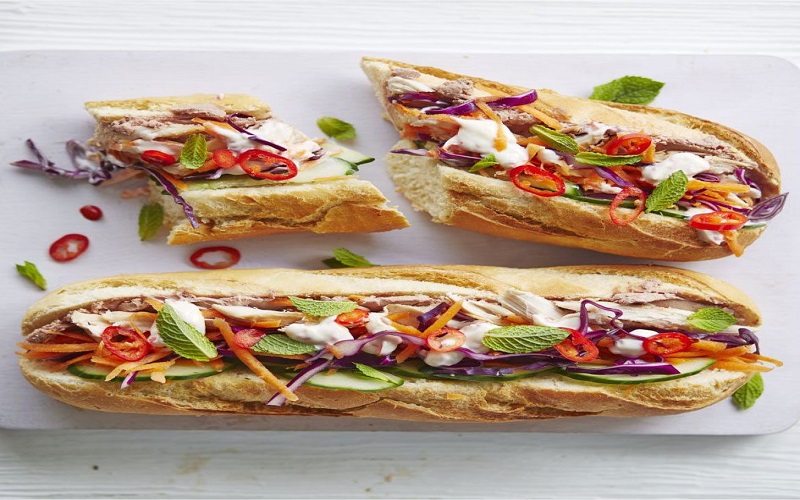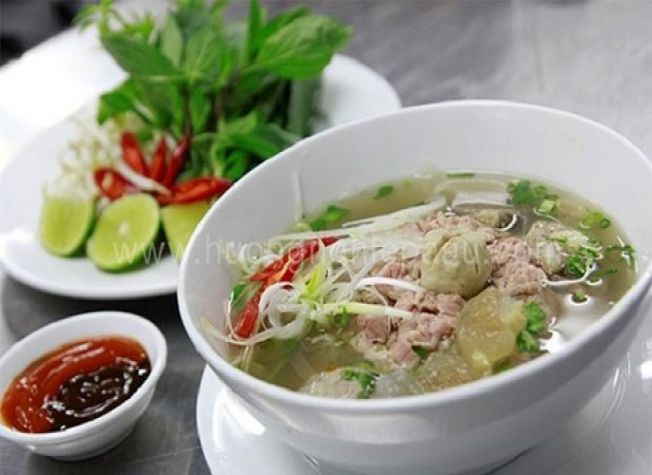Vietnamese Sandwich: History, Recipe, Ingredients to Make
Vietnamese Sandwich: No one traveling to Vietnam without trying the infamously flavourful Authentic Vietnamese Sandwich (Bánh Mì or Bánh Mỳ). The taste is beyond that of any sandwich you’d eat in any Western Nation. And we have the ultimate guide. Be prepared for a little rumble in your stomach and eye-watering images of Vietnam’s most delicious cultural export.
What is the Vietnamese Sandwich or Bánh Mì Sandwich? Essentially it is a crusty baguette with fillings. The fillings can be anything from pickled local vegetables and roast pork to chunks of meatballs in a tomato sauce. Rather than have a defined set of Vietnamese Sandwich rules, the Vietnamese have experimented and perfected a number of different varieties. With each local Vietnamese Sandwich street chef a master of their own recipe.

So, where does the Vietnamese Sandwich come from? What are the classic Vietnamese Sandwich types? Recipe and Ingredients of How to Make and to Eat? Why do people in Vietnam love eating Vietnamese Sandwich and Where to Try the Best Vietnamese Sandwich?
1. History of the Vietnamese Sandwich:
Vietnamese Sandwich is a style of bread originating from France mixed with Asian fillings. When the French invaded Vietnam and the Indochina region in 1887, the French couldn’t cope without their favourite snack: the banquette.
So flour was imported by the shipload in the mid-nineteenth century. Ham or pork was locally cured to French tastes. Cold cuts were developed to satisfy the European palette. The cheese was imported, then eventually produced in farms around the South of Vietnam.

Local pate chaud was also produced, along with European style jams. The flavors became a part of French Indochina and it’s culture. The Banh, or Pain, is the Vietnamese name for bread. They called it Banh Tay, or foreign bread. It was considered a delicacy and an expensive one.
Though initially brought in by the French to satisfy their community, it was crafted by various ethnic and geographical communities across Vietnam, eventually becoming claimed by the Vietnamese as a cuisine of national pride. The Vietnamese Sandwich has had quite the culinary journey through Vietnam during the 20th and 21st Centuries.
2. How did the Vietnamese Sandwich become Asian?
The 20th Century was a turbulent time for Planet Earth. Both World Wars changed the very nature of the Vietnamese Sandwich in Vietnam. Transport problems led to issues of importing and exporting goods. Ingredients were modified, so the Banh could still be produced. This led to a change in the production of the baguette using rice flour. This was the same flour that produced noodles. Hence, the name Vietnamese Sandwich, or bread made with a mix of wheat and rice flour.
The 1950’s changed the idea that the Baguette must stay completely European. Mass production over time made bread to be as cheap as rice or noodles. Mass-produced cheese and mayonnaise were available for use. Pate and meats were cured with Asian seasoning. Vegetables, such as carrot and radishes were sliced and pickled. Add fresh cucumber and cilantro, and you had the first Vietnamese Sandwiches in Saigon.
The Vietnamese sandwich was poised to become the legend that it is today. Hoa Ma was one of the first bakeries in Saigon. Hanoi began to sell them from baskets on bicycles. The Vietnamese Sandwich revolution had begun.
3. Basic Ingredients of Vietnamese Sandwich:
Today, most of Vietnamese Sandwich vendors and shops have their own basic practice to form the sandwich, that provide enough nutrition and calories for dinners. These are listed below:
- A roll of warm crusted bread (rice or wheat flour or 50% of both)
- A filling or fillings (cold cut slices / grilled meat / cheese / eggs / tofu)
- Pickled vegetables (carrots/daikon or white radish, usually stored in boiled white vinegar, sugar and salt and left for a few hours or days)
- Fresh vegetables (cucumber slices / cilantro / chilli)
- Spread (Mayonnaise / margerine/ cheese)
- Condiments (e.g. Soy sauce/ fish sauce/ chilli sauce)
Without the basic ingredients, it is difficult to say it’s the real deal. This is a Vietnamese Sandwich after all, not a baguette from France.
4. How to Mak the Authentic Vietnamese Sandwich?
- The bread comes out of the oven
- The bread is cut openedly in half
- The spread is applied to the bread.
- After that, the condiments are sprinkled onto the spread.
- Pate is applied to the bread. Some prefer an alternate bit of mash, such as smashed avocado, mayonaise,…
- The main filling (s) are placed on top, in slices, shreds or chunks
- These are topped with pickled vegetables
- Fresh vegetables are stuffed into the banquette
Obviously, all bakeries and vendors add their own twist to this Vietnamese sandwich. A saturated industry such as this requires a niche to have a culinary edge in the market.
The fillings differ according to specific styles produced. The Vietnamese sandwich caters to all tastes and specific dietary requirements. There’s a Vietnamese Sandwich for every occasion nowadays.
5. How Many Types of Vietnamese Sandwich?
Vietnamese Sandwich has many options available. The traditional Vietnamese Sandwich started as a meat-filled banquette with Asian flavours. Most are filled with pork, chicken and/or pate. Beef and other meats have been introduced in recent years. Here is a list of the popular local varieties. Most are pork-filled, though the Vietnamese sandwich can offer different kinds of fillings.
5.1. The meat sandwiches – grilled, fried and cold cuts: Most traditional varieties are sold at almost any Vietnamese Bakery or Vietnamese Sandwich shop. Stalls sell 1-2 kinds, usually pork filling. Each area of Vietnam has its own preferred vendor. They are served for lunch, or as a delicious and filling snack. This is Vietnamese street food the locals love to eat.
- Bánh mì Đặc Biệt (Special Sandwwich) – This is the house special. Usually one or more filings such a grilled meat or cold cuts, cheese plus the set with a special take on it. Some offer all homemade fillings, such as Huynh Hoa on Le Thi Rieng, others offer more bespoke varieties to suit their communities
- Bánh mì thịt nguội (Ham Sandwwich) – This is usually made up of 2-3 kinds of pork cold cut slices, usually fresh. Big love for the locals, this is one authentic Vietnamese Sandwich. The sliced meats and slices of ham are mixed together with mayo and cucumber added to this traditional Vietnamese Sandwich
- Bánh mì bì (Pork Skin sandwich) – shredded pork or pork skin with soy or fish sauce, with pate, mayo, pickles and fresh veg. Can be served with shredded chicken instead of pork.
- Bánh mì chả heo or Chả Lụa (Pork Roll) – pork boiled or steam in banana leaves then cooled down and served as sliced pork. The texture is similar to bologna pork meat. Just add the veg and mayo.
- Bánh mì Xiu Mai (minced pork meatball sandwich) – smashed pork meatballs marinated in a local flavoured sauce, usually with a tomato, fish or soy sauce base. This is the ultimate Subway with pork meatballs. Serve with cilantro, to get the true Vietnamese flavor.
- Bánh mì xá xíu (Pork sausage sandwich) – This is caramelised chopped up pork meat ‘char siu’Chinese style. It is marinated with Chinese seasoning and grilled on a stove pan. Add this to a baguette and this food becomes street food fav.
- Bánh mì thịt nướng (barbecue pork sandwich) – A very popular Vietnamese Sandwich for meat lovers. This is a grilled pork belly or grilled pork shoulder with the standard Vietnamese marinade infused into the pork beforehand. It’s an authentic style and one of the true original Vietnamese Sandwich from the 1950s.
- Bánh mì gà nướng (grilled chicken sandwich) – This is marinated grilled chicken with East Asian seasoning, topped with pickled fillings, fresh chilli and cilantro. The chicken is sliced and served on a hot, crispy baguette.
5.2. The pescatarian and vegetarian Vietnamese Sandwich: These options are available for any who love to eat fish, or substitute for non-meat eaters (vegan/vegetarian):
- Bánh mì cá mòi (sardine sandwich) – This is a traditional pantry style roll. It is a can of tinned sardines which are warmed in a pan, then served with all the trimmings.
- Bánh mì chả cá (fish patty sandwich) – Fried fish cakes placed into a baguette then served with Sriracha sauce, seasoning and carrot/daikon pickles with veg.
- Bánh mì chay (vegan sandwich) – This is usually eaten twice a month during the full and half-moon celebrations. Most Buddhist followers have a vegan day twice per month. They have these standard fillings:
- Solid or shredded tofu
- Vegan protein substitute meat (cold cuts)
- Hearty veg such as cauliflower or beetroot.
- The pickled vegetables, carrots and daikon use vegan white vinegar. Everything in the sandwich is vegan. This is really worth a try. The flavors can be as good as any other Vietnamese Sandwich around.
5.3. The modified original Vietnamese Sandwiches (from Colonial France): These are the original baguette fillings that were consumed in the late 19th and early 20th century, usually for breakfast.
- Bánh mì pa-tê (Pate sandwich) – Pate is usually served as part of the Vietnamese Sandwich, though it can be served as one filling. Usually, pork-based pate is served, though there are various flavors available. A seasoned vegan-based pate has really hit the streets with force recently.
- Trứng Chiên/trứng ốp-la (Fried Egg/ omelette) – Either fried eggs or an omelette cooked and served with pickled vegetables, fresh cucumber and soy sauce. The Vietnamese style can be replaced with a more basic egg, bread and margarine / soft cheese if required.
The one with butter/ margarine and peanut butter/jam – This is the basic baguette people from France missed the most back in the day. A basic roll served with butter, jam and peanut butter. Sometimes, this is served as breakfast with a fried egg.
6. Vietnamese Sandwich – The worldwide evolution:
This isn’t just street food, this is uber-street food. The Vietnamese Sandwich started from colonial origins. It was originally available to the elite only. After changes in circumstance during the 20th century, the Vietnamese Sandwich became food for the masses. The baguette quickly became Vietnamese food after a native touch was applied to the snack.
Cold cuts and sliced ham once served to ex-pats gave way to suit the local palette. Pork belly or meatballs, sliced chicken and pork, in addition to different types of fillings aroused the tastebuds of the Vietnamese people. The Vietnamese Sandwich and it’s diverse range of flavors became a favorite. The filling, complimented with pickled carrot and daikon, along with fresh cucumber and cilantro, made the Vietnamese Sandwich a must-try for any overseas visitor.
7. The Vietnamese Sandwich varieties for the foreigner:
It just can’t be an authentic Vietnamese Sandwich without adding at least one item from the list mentioned earlier in the post. The French-Vietnamese fusion of a sandwich does have a few varieties however and they come in many flavors, while sticking to the general preparation rules.
Swedish meatballs and Italian style meatballs have been introduced into the Vietnamese Sandwich in recent times. Cured Iberian or parma ham has been added to the selection of the cold cuts. Another introduction is the version of British and American style roasted meat, such as lamb, beef or chicken. Slices of roasted meat replaced the traditional versions you see in most stalls.
Mayo is mixed with other condiments such as mint sauce or mustard. Alternative spread such as avocado or smashed chutney replaces the pate. Mushrooms and cauliflower have also become the main filling for the Vietnamese Sandwich in places.
And no, these aren’t all homemade and only available in other countries, like Mr lee’s in the US. It is possible to find options like this in Vietnam. Vietnamese Sandwich 25, around the Old Quarter in Hanoi, has options to suit every sandwich lover. Expect to pay a little extra than you would at a standard bakery. These are premium sandwiches.
The Europeans love a sandwich. The Vietnamese made an East-Asian sandwich that people love. The varieties of pork, the succulent cold cuts, the soft pate spread mixed with the set mayo and crunchy pickles on a crisp and crusty warm baguette. This is the best Vietnamese snack. Time to go, as I think I need one now. Writing this post has left me famished. A Vietnamese meatball Vietnamese Sandwich sub coming right up!
Recommende Places in Hanoi to try Vietnamese Banh Mi
Banh Mi 25 - A Must Visit in Hanoi for Banh Mi
- Price range: 20,000 – 35,000 VND (~ 1 – 2 USD)
- Address: 25 Hang Ca, Hoan Kiem district, Hanoi
- Opening time: 07:00 AM – 9:00 PM
Banh Mi Pho Co:
- Price range: 20,000 – 40,000 VND (~ 1 – 2 USD)
- Address: 38 P. Dinh Liet Hang Dao, Hoan Kiem district, Hanoi
- Opening time: 07:30 AM – 12:00 AM
Banh Mi Chay (Vegetarian Banh Mi):
- Price range: 10,000 – 20,000 VND (~ 1 USD)
- Address: 66B Tran Hung Dao, Hoan Kiem district, Hanoi
- Opening time: 11:00 AM – 7:30 PM
Banh Mi Minh Nhat:
- Price range: 32,000 – 60,000 VND (~ 2 – 3 USD)
- Address: 27 Nguyen Du, Hai Ba Trung district, Hanoi
- Opening time: 7 AM – 10 PM
Banh Mi P:
- Price range: 30,000 – 50,000 VND (~ 2 – 3 USD)
- Address: 12 Hang Buom, Hoan Kiem district, Hanoi
- Opening time: 7 AM – 6 PM
Bami An Bread:
- Price range: 15,000 – 30,000 VND (~ 1 – 2 USD)
- Address: 128 Giang Vo, Ba Dinh district, Hanoi
- Opening time: 7 AM – 10:30 PM
Banh Mi Pho Hue:
- Price range: 20,000 – 50,000 VND (~ 1 – 3 USD)
- Address: 118A Pho Hue, Hai Ba Trung district, Hanoi
- Opening time: 8 AM – 5 PM
Banh Mi Lan Ong (Old Quarter):
- Price range: 15,000 – 35,000 VND (~ 1 – 2 USD)
- Address: 20 Cha Ca, Hoan Kiem district, Hanoi
- Opening time: 7 AM – 10 PM
Banh Mi Hong Mai:
- Price range: 20,000 – 40,000 VND (~ 1 – 2 USD)
- Address: 160 Hong Mai, Hai Ba Trung district, Hanoi
- Opening time: 2 PM – 12 AM
Recommende Places to Try Banh Mi in Hoi An & Da Nang:
Banh Mi Phuong - Clich to See >>>
- Address: 2b Phan Chu Trinh, Hoi An Ancient Town
- Opening Hours: 6:30 a.m – 9:30 p.m. Monday – Sunday
- Cost: 15,000 to 35,000 VND (0.65 c to 1.50 USD)
- Madam Khanh – The Banh Mi Queen:
- Address: 115 Tran Cao Van
- Opening Hours: 7 a.m – 7 p.m. Monday – Sunday
- Cost: 20,000 VND (0.85c USD)
- Phi Banh Mi:
- Address: Cam Pho, Hoi An City
- Opening Hours: 8 a.m – 8 p.m. Monday – Sunday
- Cost: 15,000 to 35,000 VND (0.65c to 1.50 USD)
- Banh Mi Lanh:
- Address: Cam Chau, Hoi An, Quang Nam
- Opening Hours: Advertised as 6:00 a.m – 9:30 p.m. Monday – Sunday
- Cost: 20,000 VND (0.85c USD)
- Banh Mi Chay (Vegetarian Banh Mi):
- Address: Phan chau trinh and Nguyen hue, Hoi An City
- Opening Hours: 6:30 a.m. – 10 a.m (or when she sells out)
- Cost: 15,000 VND (0.60c USD)
- Drunk Banh Mi Stand:
- Address: An Hoi, Hoi An, Quang Nam Province
- Opening Hours: After 9.30 p.m. unfixed days
- Cost: 25,000 VND (1 USD) – 30,000 VND (1.30 USD)
Recommende Places in Saigon to Try Banh Mi:
Banh mi Huynh Hoa: 26 Le Thi Rieng Street, District 1, Ho Chi Minh City.
Bánh mì Tám Cẩu: 460 Dien Bien Phu Street, District 10, Ho Chi Minh City.
Bánh mì Bảy Hổ: 19 Huynh Khuong Ninh, District 1, Ho Chi Minh City.
Bánh Mì Tuấn Mập: 196 Pasteur, District 3, Hồ Chí Minh City
Bánh Mì Hòa Mã: 53 Cao Thắng Street, District 3, Ho Chi Minh City
Ms. Diep's Bread: 238 Vo Thanh Trang, Ward 11, Tan Binh District
Banh Mi Nguyen Trai: First Alley 39 Nguyen Trai, District 1
Banh Mi Bay Ho:19 Huynh Khuong Ninh, Da Kao, District 1
See Also:

Best of Vietnam

Best Vietnamese Food You Have to Try in Vietnam
Best Food in Vietnam: Vietnamese Traditional Food is top World well known to be both healthy and...

10 Best National Parks in Vietnam
Vietnam Travel Guide: If you look for the Best Wildlife Discovery Experience in Vietnam, here are...
Read More
Best Souvenir to Buy in Vietnam
If you look for Best Things to Buy when traveling to Vietnam to bring home for your family & friends...
Read More
The 10 Best Places to Visit in Vietnam
Vietnam Travel Guide: Home to an extensive collection of historical and cultural attractions,...
Read More
Top 10 Museums You Should Not Miss in Vietnam
Vietnam, 4.000 years old country has a unique and lengthy history, culture with 54 ethnic groups. It...
Read MoreFind your trip
Vietnam Best Tours
Vietnam Car Rental
Vietnam Travel Blog
- Vietnamese People: Origin, History, Culture and Traditions
- Vietnam Currency: Best ATM and Places to Exchange Money
- Vietnam Map: Regions, Cities & Provinces Map of Vietnam
- What is illegal Things in Vietnam: Rules & Laws for Tourists
- Best Time to Travel to Vietnam to Avoid the Bad Weather
- Vietnam News: Population & Religions of 54 Ethnic Groups









